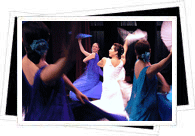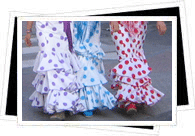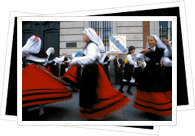
While many first-time travelers to Spain think of passionate flamenco as being Spain's so-called "national" music, traditional Spanish music is far more complex. In fact, flamenco music didn't even formally hit the Spanish music scene until around the beginning of the 19th century, centuries after the evolution of other traditional Spanish music. However, while most of Spain's regional dance and music fly well beneath the international music radar, flamenco has become a recognizable sensation around the globe.
Spain's traditional music is essentially a multi-faceted mosaic of the many cultures of Spain's long and colorful history. For this reason, the traditional music and dance vary as you travel from region to region. The traditional music of the Islas Canarias (Canary Islands), for example, boasts influences from the archipielago's mysterious indigenous Guanche civilization while the bagpipe music of Galicia and Asturias speaks volumes about these northern regions' rich Celtic heritage.
 Traditional Spanish music throughout Spain's vastly diverse regions first flourished while the country was still under Moorish rule. For much of these period (up to eight centuries, in some areas), Spain's Christian, Jewish and Muslim communities coexisted rather peacefully and various facets of their respective culture were free to develop. With the Reconquest, the development of traditional Spanish music came to a temporary standstill, as the ultra-Christian Spanish monarchy (Fernando and Isabel were called the "Catholic Kings," after all) eventually banned Sephardic and Islamic music.
Traditional Spanish music throughout Spain's vastly diverse regions first flourished while the country was still under Moorish rule. For much of these period (up to eight centuries, in some areas), Spain's Christian, Jewish and Muslim communities coexisted rather peacefully and various facets of their respective culture were free to develop. With the Reconquest, the development of traditional Spanish music came to a temporary standstill, as the ultra-Christian Spanish monarchy (Fernando and Isabel were called the "Catholic Kings," after all) eventually banned Sephardic and Islamic music.
The Renaissance and Baroque periods were clutch for the evolution of traditional Spanish music. However, the classical music typical of the Renaissance fell into the shadow of the light-hearted folk music of the Baroque. The zarzuela, an immensely popular light Spanish opera, is based on popular music and culture.
During the 35-year dictatorship of 20th century Spanish dictator Francisco Franco, regional music and dance were banned. Intent on creating a uniform and nationalist country, he wanted to do away with all things regional- languages, literature, festivals, music, etc. His death in 1975 sparked a huge boost in regional pride, which has in turn yielded a major revival of Spanish traditional folk music.

Spanish culture is jam-packed with traditional music and dance- in fact, at one point there were over 200 traditional dances documented in Cataluña alone! Below you'll find a brief run-down of some of Spain's most popular music and accompanying dances.